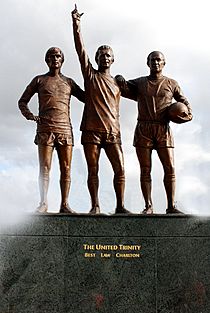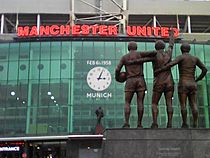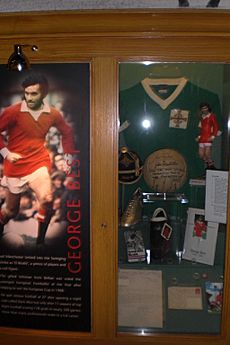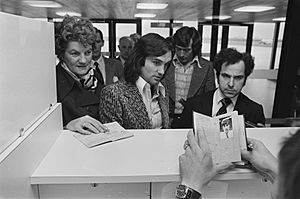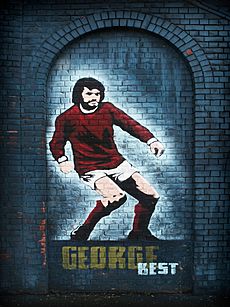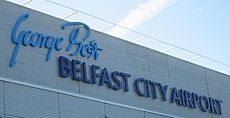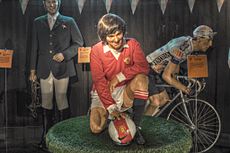George Best facts for kids
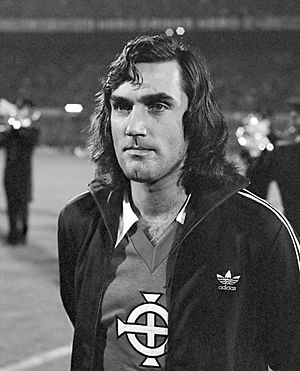
Best with Northern Ireland in 1976
|
|||
| Personal information | |||
|---|---|---|---|
| Full name | George Best | ||
| Date of birth | 22 May 1946 | ||
| Place of birth | Belfast, Northern Ireland | ||
| Date of death | 25 November 2005 (aged 59) | ||
| Place of death | South Kensington, London, England | ||
| Height | 5 ft 9 in (1.75 m) | ||
| Playing position | Winger, attacking midfielder | ||
| Youth career | |||
| Cregagh Boys Club | |||
| 1961–1963 | Manchester United | ||
| Senior career* | |||
| Years | Team | Apps† | (Gls)† |
| 1963–1974 | Manchester United | 361 | (137) |
| 1974 | Dunstable Town | 0 | (0) |
| 1975 | Stockport County | 3 | (2) |
| 1975–1976 | Cork Celtic | 3 | (0) |
| 1976 | Los Angeles Aztecs | 23 | (15) |
| 1976–1977 | Fulham | 42 | (8) |
| 1977–1978 | Los Angeles Aztecs | 32 | (12) |
| 1978–1979 | Fort Lauderdale Strikers | 28 | (6) |
| 1979–1980 | Hibernian | 17 | (3) |
| 1980–1981 | San Jose Earthquakes | 56 | (21) |
| 1982–1983 | AFC Bournemouth | 5 | (0) |
| 1983 | Brisbane Lions | 4 | (0) |
| Total | 574 | (204) | |
| National team | |||
| 1964–1977 | Northern Ireland | 37 | (9) |
|
|||
George Best (22 May 1946 – 25 November 2005) was a Northern Irish professional footballer who played as a winger, spending most of his club career at Manchester United. A highly skilful dribbler, Best is regarded as one of the greatest players in the history of the sport. He was named European Footballer of the Year in 1968 and came fifth in the FIFA Player of the Century vote. Best received plaudits for his playing style, which combined pace, skill, balance, feints, two-footedness, goalscoring and the ability to get past defenders.
Born in Belfast, Best began his club career in England with Manchester United, with the scout who had spotted his talent at the age of 15 sending a telegram to manager Matt Busby which read: "I think I've found you a genius". After making his debut aged 17, he scored 179 goals from 470 appearances over 11 years and was the club's top goalscorer in the league for five consecutive seasons. He won two League titles and the European Cup with the club. His style of play on the field captured the public's imagination, and in 1999 he was on the six-man short-list for the BBC's Sports Personality of the Century. He was also an inaugural inductee into the English Football Hall of Fame in 2002.
In international football, Best was capped 37 times for Northern Ireland between 1964 and 1977. A combination of the team's performance and his lack of fitness in 1982 meant that he never played in the finals of a major tournament. He considered his international career as being "recreational football", with the expectations placed on a smaller nation in Northern Ireland being much less than with his club. He is regarded as one of the greatest players never to have played at a World Cup. The Irish Football Association described him as the "greatest player to ever pull on the green shirt of Northern Ireland".
With his good looks, dark Beatle mop-top hair and playboy lifestyle, Best became one of the first media celebrity footballers, earning the nickname "o Beatle" by Portuguese press reporters after a stand-out performance for Manchester United in Lisbon in March 1966. However, his extravagant lifestyle led to various personal problems. These issues affected him on and off the field, often causing controversy. Although conscious of his problems, he made light of them: "I spent a lot of money on birds and fast cars – the rest I just squandered". After football, he spent some time as a football analyst, but his financial and health problems continued into his retirement. He died in 2005, aged 59, due to complications from the immunosuppressive drugs he needed to take after a liver transplant in 2002.
Contents
Early years and family
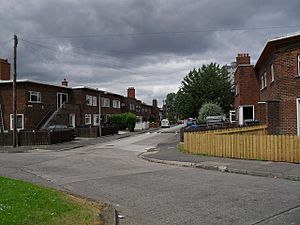
George Best was the first child of Richard "Dickie" Best (1919–2008) and Anne Withers (1922–1978). He was born on 22 May 1946 and grew up in Cregagh, east Belfast. Best was brought up in the Free Presbyterian faith. His father was a member of the Orange Order and as a boy George carried the strings of the banner in his local Cregagh lodge. In his autobiography, Best mentioned how important the order was to his family. Best had four sisters, Carol, Barbara, Julie and Grace, and one brother, Ian (Ian Busby Best).
Best's mother Anne died from cardiovascular disease in 1978, at the age of 55. Best's father died on 16 April 2008, at the age of 88, in the Ulster Hospital in Dundonald, Northern Ireland.
In 1957, the academically gifted Best passed the 11-plus and went to Grosvenor High School, but he soon played truant as the school specialised in rugby union. Best then moved to Lisnasharragh Secondary School, reuniting him with friends from primary school and allowing him to focus on football. He played for Cregagh Boys Club. He grew up supporting Glentoran and Wolverhampton Wanderers.
Club career
Manchester United
At the age of 15 Best was discovered in Belfast by Manchester United scout Bob Bishop, whose telegram to United manager Matt Busby read: "I think I've found you a genius." His local club Glentoran had previously rejected him for being "too small and light". Best was subsequently given a trial and signed up by United's chief scout Joe Armstrong. His first time moving to the club, Best quickly became homesick and stayed for only two days before going back home to Northern Ireland. He returned to Manchester and spent two years as an amateur, as English clubs were not allowed to take Northern Irish players on as apprentices. He was given a job as an errand boy on the Manchester Ship Canal, allowing him to train with the club twice a week.
Best made his First Division debut, aged 17, on 14 September 1963 against West Bromwich Albion at Old Trafford in a 1–0 victory. He then dropped back into the reserves, before scoring his first goal for the first team in his second appearance in a 5–1 win over Burnley on 28 December. Manager Matt Busby then kept Best in the team, and by the end of the 1963–64 season, he had made 26 appearances, scoring six goals. Manchester United finished second, four points behind Liverpool. They also reached the semi-finals of the FA Cup, where a defeat to West Ham United cost Best the chance to break a record; in the final Preston North End's Howard Kendall became the youngest ever player in a FA Cup Final – he shared the same birth date as Best. That same season, Best captained the Manchester United side that won the 1964 FA Youth Cup, the sixth FA Youth Cup won under the management of Jimmy Murphy, and the first since the 1958 Munich air disaster.
Though opponents would often use rough play to try to stifle his technical ability, Busby ensured that "fierce, sometimes brutal" training sessions left Best well used to coping with tough challenges. In the 1964–65 season, his first full season as a first team regular, Best helped Manchester United to claim the league title. A 1–0 victory at Elland Road proved decisive as the title race came down to goal average between the "Red Devils" and bitter rivals Leeds United; Leeds did manage to gain some measure of revenge though by knocking Manchester United out of the FA Cup at the semi-final stage. Over the course of the campaign Best contributed 14 goals in 59 competitive games. He scored the opening goal of the 1965 FA Charity Shield at Old Trafford, which ended in a 2–2 draw with Liverpool.
The rising star of English football, Best was catapulted to superstar status at the age of 19 when he scored two goals in a European Cup quarter-final match against Benfica at the Estádio da Luz on 9 March 1966. His stand-out display allied with his dark Beatle mop-top hair, the Portuguese media dubbed him "O Quinto Beatle" ("the fifth Beatle"), and on the team's return to England, Best was photographed on the airport tarmac in his new sombrero with the headline, "El Beatle". His talent and showmanship made him a crowd and media favourite, and he went from being headline news in the back pages to the front pages.
Other nicknames included the "Belfast Boy", and he was often referred to as Georgie, or Geordie in his native Belfast. However United failed to win any major honours in the 1965–66 season, and Best was injured from 26 March onwards with a twisted knee following a bad tackle from a Preston North End player. However United staff claimed it was light ligament damage so as to keep Best on the field for the rest of the campaign. He had little faith in the United medical staff, and so he secretly saw Glentoran's physiotherapist, who readjusted his ligaments in a painful procedure. His last game of the season, his knee strapped-up, came on 13 April, and ended in a 2–0 defeat to Partizan Belgrade at Partizan Stadium.
The 1966–67 season was again successful, as Manchester United claimed the league title by four points. Best stated that "if the championship was decided on home games we would win it every season. This time our away games made the difference. We got into the right frame of mind." An ever-present all season long, he scored 10 goals in 45 games. He then helped the "Red Devils" to share the Charity Shield with a 3–3 draw with FA Cup winners Tottenham Hotspur; it was the first game to be broadcast in colour on British television.
Best scored twice against rivals Liverpool in a 2–0 win at Anfield, and also claimed a hat-trick over Newcastle United in a 6–0 home win on the penultimate league game of the season. However a home defeat to hated local rivals Manchester City proved costly, as City claimed the league title with a two-point lead over United. Yet the 1967–68 season would be remembered by United fans for the European Cup win. After disposing of Maltese Hibernians, United advanced past Yugoslavian Sarajevo with a 2–1 home win – Best assisted John Aston for the first and scored the second himself, and was described by Geoffrey Green of The Times as "the centrepiece of the chessboard ... a player full of fantasy; a player who lent magic to what might have been whimsy". In the quarter-finals United advanced past Polish club Górnik Zabrze 2–1 on aggregate, having held on to their aggregate lead in freezing temperatures in front of 105,000 at Silesian Stadium; despite losing the away tie 1–0, Best described the defeat as "one of our best-ever performances, given all the unwelcome circumstances". Facing six times champions Real Madrid in the semi-finals, Best scored the only goal of the home fixture with a 15-yard strike that Alex Stepney described as one of Best's finest goals. In the tie at the Bernabéu, Best was marked effectively by Manuel Sanchís Martínez, but on the one time Best got the better of him he made a telling cross to Bill Foulkes, who calmly found the net to level the game at 3–3 and to win the aggregate tie 4–3.
Days after returning to England, as the First Division's joint top-scorer (level on 28 goals with Southampton's Ron Davies) Best was presented with the FWA Footballer of the Year award, becoming the youngest ever recipient of the award. Facing United in the European Cup Final at Wembley were Benfica; while his teammates rested, Best found "a novel way to relax" before the big game by sleeping with "a particular young lady called Sue". The game went into extra-time, and just three minutes into extra-time Best went on a mazy run and beat goalkeeper José Henrique with a dummy, before rolling the ball into the net; two further goals from Brian Kidd and Bobby Charlton settled the tie at 4–1. The victory was not only the pinnacle of Best's career, but arguably Manchester United's greatest achievement, considering the Munich air disaster had wiped out most of the Busby Babes just ten years previously. Best also won the Ballon d'Or in 1968 after receiving more votes than Bobby Charlton, Dragan Džajić and Franz Beckenbauer. This meant that he had won the three major honours in club football at the age of just 22 (the league title, European Cup, and European Player of the Year award). After this, his steady decline began.
However, the 'holy trinity' of Best, Law and Charlton were still as effective as ever in the 1968–69 campaign. Although, it became obvious that the club's new recruits were not up to scratch as United dropped to 11th in the league before Busby announced his retirement. Best later said that "I increasingly had the feeling that I was carrying the team at times on the pitch." He scored 22 goals in 55 games, though only he and Denis Law scored more than six league goals. In the Intercontinental Cup, fans and players alike looked forward to seeing United take on Argentine opposition Estudiantes de La Plata over the course of two legs. However Best said "no one tackled harder or dirtier than this Argentinian team" as a 1–0 defeat at the Estadio Camilo Cichero was followed by a 1–1 draw at Old Trafford. In the home tie, Best was kicked and spat on by José Hugo Medina, and both players were sent off after Best reacted with a punch. Despite their poor league form, United managed to reach the semi-finals of the European Cup (they had a relatively easy run in getting past the Republic of Ireland's Waterford United, Belgium's Anderlecht, and Austria's Rapid Wien) where they were knocked out 2–1 on aggregate by A.C. Milan following a 2–0 defeat at the San Siro; Milan goalkeeper Fabio Cudicini was the hero after keeping United to only one goal at Old Trafford.
"It's been a joke on the circuit ever since. You know, I'm on one side of the street, George Best is on the other. He nods to me and I dive under a bus."
United improved slightly under new boss Wilf McGuinness, but still only managed an eighth-place finish in the 1969–70 season. Best hit 23 goals, including an FA Cup record six goals in an 8–2 win over Northampton Town in a mud-bath at the County Ground on 7 February 1970. Best's sixth goal saw him go one on one with Northampton goalkeeper Kim Book. Best made a feint to go right which put Book on his backside, before he went left and walked the ball into the net. Best's six goal performance earned him an invitation to No 10 Downing Street from UK Prime Minister Harold Wilson, who had also regularly written fan letters to him. In 2002 the British public voted Best's record breaking performance No. 26 in the list of the 100 Greatest Sporting Moments. Busby returned as manager in December 1970, though the 1970–71 season also ended without a trophy. Best began to get into trouble with his discipline: he was fined by the Football Association for receiving three bookings for misconduct, and he was suspended by United for two weeks after missing his train to Stamford Bridge so as to spend a weekend with actress Sinéad Cusack.
New manager Frank O'Farrell led United to an eighth-place finish in 1971–72. Highlights for Best included hat-tricks against West Ham United and Southampton, as well as a goal against Sheffield United that came after he beat four defenders in a mazy run. However, he was also sent off against Chelsea, was the subject of death threats, and failed to turn up for training for a whole week in January as he instead spent his time with Miss Great Britain 1971, Carolyn Moore. On 17 November, he was the subject of Eamonn Andrews's biographical television show This Is Your Life when he was surprised at a central London restaurant. He would be the subject for a second time in 2003 when Michael Aspel surprised him at Teddington Studios. With 27 goals in 54 appearances, Best finished as the club's top-scorer for the sixth – and final – consecutive season. Best then announced his retirement from football, but nevertheless turned up for pre-season training, and continued to play.
United's decline continued in the 1972–73 season, as Best was part of the 'old guard clique' that barely talked to the newer, less talented players. Frustrated with the club's decline, Best went missing in December to party at the London nightclubs. He was suspended, and transfer-listed at a value of £300,000. After O'Farrell was replaced as manager by Tommy Docherty, Best announced his retirement for a second time. He resumed training on 27 April.
Best's last competitive game for the club was on 1 January 1974 against Queens Park Rangers at Loftus Road, which United lost 3–0. He failed to turn up for training three days later and was dropped by Docherty, though he claimed Docherty was deceitful with him. Best was arrested and charged with stealing a fur coat, passport, and cheque book from Marjorie Wallace, but was later cleared of all charges. United went on to suffer relegation into the Second Division in 1973–74.
Best played at United when shirt numbers were assigned to positions, and not the player. When Best played at right wing, as he famously did during the later stages of the 1966 and 1968 European Cups, he donned the number 7. As a left winger, where he played exclusively in his debut season and nearly all of the 1971–72 campaign, he wore the number 11. Best wore the number 8 shirt at inside right on occasion throughout the 1960s, but for more than half of his matches during 1970–71. He was playing at inside left (wearing the number 10) in 1972 when he famously walked out on United the first time but was back in the number 11 for the autumn of 1973 before leaving for good. Best even wore the number 9 jersey once for United, with Bobby Charlton injured, on 22 March 1969 at Old Trafford, scoring the only goal in a 1–0 win over Sheffield Wednesday. In total Best made 470 appearances for Manchester United in all competitions from 1963 to 1974, and scored 179 goals. Over the next decade he went into an increasingly rapid decline, drifting between several clubs, including spells in South Africa, the Republic of Ireland, the United States, Scotland, and Australia.
Later years
Playing only five competitive matches for Jewish Guild in South Africa, Best endured criticism for missing several training sessions. During his short time there, he was the main draw attracting thousands of spectators to the matches.
In 1975, Best played three matches for Stockport County in the Fourth Division. He had a brief spell at Cork Celtic from December 1975 to January 1976. He made his League of Ireland debut against Drogheda United at Flower Lodge on 28 December. He played only three league games, the others against Bohemians and Shelbourne, but despite attracting big crowds he failed to score or impress. Being on a rolling contract with Cork his failure to show for a game saw him being dropped and subsequently leaving the club.
He had a brief resurgence in form with Second Division club Fulham in 1976–77, showing that, although he had lost some of his pace, he retained his skills. His time with the "Cottagers" is particularly remembered for a match against Hereford United on 25 September 1976 in which he jokingly tackled his own teammate, and old drinking mate, Rodney Marsh. Best and Marsh were drawn to the club by the presence of England World Cup winning captain Bobby Moore, and they were involved in exuberant goal celebrations.
Best played for three clubs in the United States: Los Angeles Aztecs, Fort Lauderdale Strikers and later San Jose Earthquakes; he also played for the Detroit Express on a European tour. Best was a success on the field, scoring 15 goals in 24 games in his first season with the Aztecs and named as the NASL's best midfielder in his second. He and manager Ken Adam opened "Bestie's Beach Club" (now called "The Underground" after the London subway system) in Hermosa Beach, California in the 1970s, and continued to operate it until the 1990s.
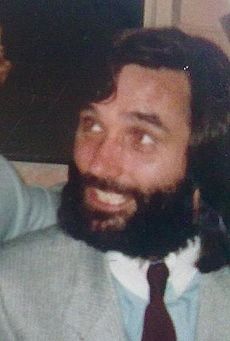
Best caused a stir when he returned to the UK to play for the Scottish club Hibernian. The club was suffering a decline in fortunes and was heading for relegation from the Premier Division, before Best was signed on a "pay per play" basis after the club chairman, Tom Hart, received a tip-off from an Edinburgh Evening News reporter that he was available. Even though Best failed to save Hibs from relegation, gates increased dramatically, and the attendance quadrupled for his first match at Easter Road. One infamous incident saw Best initially sacked by Hibs after he went on a massive drinking session with the French rugby team, who were in Edinburgh to play Scotland. He was brought back a week later. In August 1982, he played 20 minutes for Scone Thistle against Scone Amateurs; the appearance fee he received helped to pay off an income tax bill.
He returned to the US to play for the San Jose Earthquakes in what was officially described as a "loan", though he only managed a handful of appearances for Hibs in the First Division in the following season. He returned one last time to Easter Road in 1984, for Jackie McNamara's testimonial match against Newcastle United. In his third season in the States, Best scored once in 12 appearances. His moves to Fort Lauderdale and San Jose were also unhappy, as his off-field demons began to take control of his life again. After failing to agree terms with Bolton Wanderers in 1981, he was invited as a guest player and played three matches for two Hong Kong First Division teams (Sea Bee and Rangers) in 1982. At HK Rangers he played alongside his former Northern Ireland teammate Derek Spence. While in Hong Kong, Best also played darts for a team called Presstuds, made up of a combination of professional footballers and sports journalists.
In late 1982, AFC Bournemouth manager Don Megson signed the 36-year-old Best for the Third Division side, and he remained there until the end of the 1982–83 season, when he retired from football at the age of 37. Best played in a friendly for Newry Town against Shamrock Rovers in August 1983, before ending his professional career exactly 20 years after joining Manchester United with a brief four-match stint playing for the Brisbane Lions in the Australian National Soccer League during the 1983 season. He also was a guest player for an exhibition match between Dee Why Football Club and Manly Warringah held on 27 July 1983; Dee Why won the match 2–1, with Best having scored the winning goal. On 29 October 1984, Best played as a special guest for Reading against the New Zealand national team in a friendly game, alongside 1966 World Cup winner Martin Peters. Reading were defeated 2–1.
On 8 August 1988, a testimonial match was held for Best at Windsor Park. Among the crowd were Sir Matt Busby, Jimmy Murphy, and Bob Bishop, the scout who discovered Best, while those playing included Osvaldo Ardiles, Johan Neeskens, Pat Jennings and Liam Brady. Best scored twice, one goal from outside the box, the other from the penalty spot.
International career
Best was capped 37 times for Northern Ireland, scoring nine goals. Of his nine international goals, four were scored against Cyprus and one each against Albania, England, Scotland, Switzerland and Turkey. Largely surrounded by teammates of lesser ability with Northern Ireland than with his club and lower expectations as a result, Best considered his international career as being "recreational football". He is regarded as one of the greatest players never to have played at a World Cup, and like his namesake, Liberia star George Weah, he was “hamstrung in World Cup terms by hailing from a global minnow”.
On 15 May 1971, Best scored possibly the most famous "goal" of his career at Windsor Park in Belfast against England. As Gordon Banks, the English goalkeeper, released the ball in the air in order to kick the ball downfield, Best managed to kick the ball first, which sent the ball high over their heads and heading towards the open goal. Best outpaced Banks and headed the ball into the empty goal, but the goal was disallowed by referee Alistair Mackenzie.
Best continued to be selected for Northern Ireland throughout the 1970s, despite his fluctuating form and off pitch problems. Dutch captain Johan Cruyff commented: "What he [Best] had was unique, you can't coach it".
Best was considered briefly by manager Billy Bingham for the 1982 World Cup, but at the age of 35, with his football skills dulled by age and drink (and five years having passed since his last cap), he was not selected for the Northern Ireland squad. A proponent of a United Ireland football team, in 2005 Best stated: "I've always thought that at any given time both the Republic and Northern Ireland have had some great world-class players. I still hope that in my lifetime it happens."
Style of play
A highly skilful winger, considered by several pundits to be one of the greatest dribblers in the history of the sport, Best received plaudits for his playing style, which combined pace, skill, balance, feints, two-footedness, goalscoring and the ability to get past defenders. Recalling Best's career and style of play, sports writer Patrick Barclay said: "In terms of ability he was the world's best footballer of all time. He could do almost anything – technically, speed, complete mastery of not only the ball but his own body. You could saw his legs away and he still wouldn't fall because his balance was uncanny, almost supernatural. Heading ability, passing ability, I mean it goes without saying the dribbling – he could beat anybody in any way he chose. For fun he'd play a one-two off the opponent's shins."
Although Best was mostly renowned for his dribbling skills, he also drew praise for his ability as a creator; in regard to this ability, Daily Telegraph reader Tony Dove commented: "I only had the opportunity to see George play once in person – Man U played a tour game in Auckland, New Zealand, late in the 60s. His brilliance was simply dazzling – player after player from the New Zealand national team queued up to try to tackle him and he gave them all dancing lessons. I clearly remember one run, starting almost from the goal-line, from a roll-out by Stepney, when he evaded every player in the NZ team, one after the other, until he reached the opposite end of the pitch and produced a perfectly floated centre for Charlton's head. His grace, agility and ball skills were only eclipsed by his unselfish passing – many love to remark on his goal scoring but he was prodigious as the set-up man. On the field you couldn't ask for a better football role-model. Let the man pass with what dignity remains to him. Remember him at his best."
In an interview, Manchester United's Alex Stepney said, "Best would knock the ball on to the goalkeeper's shin, who would be rushing towards this feet to close down the angle, and the ball would bounce back to him and he would score. No one has been able to emulate that in football. Not only did he do it in training but he did it against Manchester United's arch rivals Liverpool at Anfield."
Personal life
During his early years at Old Trafford, Best was a shy teenager who passed his free time in snooker halls. However, he later became known for his long hair, good looks and extravagant celebrity lifestyle, and appeared on Top of the Pops in 1965.
He opened a nightclub called Slack Alice on Bootle Street in Manchester in 1973 and owned restaurants in the city including Oscars, on the site of the old Waldorf Hotel. He also owned fashion boutiques, in partnership with Manchester City player Mike Summerbee. Best's cousin Gary Reid, a member of the Ulster Defence Association, was killed in 1974 during an episode of serious rioting in east Belfast.
Best married Angela MacDonald-Janes on 24 January 1978 at Candlelight Wedding Chapel in Las Vegas, having met her in the United States when Best was playing for the Los Angeles Aztecs in 1976. Their son, Calum, was born in 1981, but they separated in 1982 and divorced in 1986.
He married Alex Pursey in 1995 in Kensington and Chelsea, London. They divorced in 2004 with no children. In 2004, she alleged that Best was violent towards her at times during their marriage, an issue that was covered in Best's authorised 1998 biography "Bestie" in which Alex claimed that Best punched her in the face on more than one occasion. Earlier in the book it is revealed that he struck another of his girlfriends at least once and was arrested and charged with assault on a waitress, Stevie Sloniecka, in November 1972, when he fractured her nose in Reuben's nightclub, Manchester. He was successfully defended when the case reached court in January 1973 by barrister George Carman QC, a close drinking companion of Best, as acknowledged in his book, Scoring at Half Time.
At the peak of his career in the late 1960s and early 1970s, Best advertised Cookstown sausages on television with the phrase "the Best family sausages". In 2007 a memorial plaque was placed outside the pork factory in the County Tyrone town. In the early 1970s, Best also advertised eggs, under the campaign "E for B and Georgie Best," both in print and on TV, where "E for B" was short for "Eggs for Breakfast."
Best had a cameo as himself in the 1971 British comedy film Percy. In 1984, he made a fitness album with Mary Stävin called Shape Up and Dance. The Farm's video for their 1992 cover version of The Human League's "Don't You Want Me" featured Best mouthing the chorus. A biographical film entitled Best was released in May 2000, with John Lynch portraying George Best. Indie rock band The Wedding Present named their first album George Best, and featured Best on the cover wearing his red Manchester United kit. After his death, Brian Kennedy and Peter Corry released a single entitled George Best – A Tribute. Best features in EA Sports' FIFA video game series; he was included as an icon in the FIFA 19 Ultimate Team Legends.
In 2007, GQ magazine named him as one of the 50 most stylish men of the past 50 years. When Best played football, salaries were a fraction of what top players earn today, but, with his pop star image and celebrity status, Best still earned a fortune. He lost almost all of it. When asked what happened to the money he had earned, Best quipped: "I spent a lot of money on birds (women) and fast cars. The rest I just squandered."
In 2012, Best was featured in the list of The New Elizabethans to mark the diamond Jubilee of Queen Elizabeth II. A panel of seven academics, journalists and historians named Best among the group of people in the UK "whose actions during the reign of Elizabeth II have had a significant impact on lives in these islands and given the age its character".
Death
Best continued to drink, and was sometimes seen at his local pub in Surbiton, London. On 3 October 2005, he was admitted to intensive care at the private Cromwell Hospital in London, suffering from a kidney infection caused by the side effects of immuno-suppressive drugs used to prevent his body from rejecting his transplanted liver. On 27 October, newspapers stated that Best was close to death and had sent a farewell message to his loved ones. Close friends in the game visited his bedside to make their farewells, including Rodney Marsh, and the two other members of the "United Trinity", Bobby Charlton and Denis Law. In the early hours of 25 November 2005, treatment was stopped; later that day he died, aged 59, as a result of a lung infection and multiple organ failure.
Tributes were paid to Best from around the world, including from arguably three of the greatest football players ever, Pelé, Diego Maradona and Johan Cruyff. Maradona commented: "George inspired me when I was young. He was flamboyant and exciting and able to inspire his teammates. I actually think we were very similar players – dribblers who were able to create moments of magic." Fellow Manchester United legend Eric Cantona gave a eulogy to Best: "I would love him to save me a place in his team, George Best that is, not God."
The Premier League announced that a minute's silence would be observed before all Premier League games to be held over the weekend of his death; however at many grounds a minute's applause broke out in his honour. The first match at Old Trafford after Best's death was a League Cup tie against West Bromwich Albion, the club against which he made his debut for Manchester United in 1963. The match, which United won, was preceded by tributes from former teammate Sir Bobby Charlton. Best's son Calum and former teammates, surviving members from the West Brom team which he played against in his debut, all joined the current United squad on the pitch for a minute's silence, during which fans in every seat held aloft pictures of Best, which were given out before the match.
Funeral
His body left the family home at Cregagh Road, East Belfast, shortly after 10:00 UTC on Saturday, 3 December 2005. The cortege then travelled the short distance to Stormont. The route was lined with around 100,000 mourners. Former Northern Ireland manager Billy Bingham, international teammates Derek Dougan, Peter McParland, Harry Gregg, Gerry Armstrong and Denis Law were the first to carry the coffin to the base of the Stormont steps.
There was an 11 am service in the Grand Hall attended by 300 invited guests relayed to around 25,000 mourners inside the grounds of Stormont. Best's brother Ian, agent Phil Hughes, Dr Akeel Alisa, who treated Best, and his brothers-in-law Norman McNarry and Alan McPherson, were also pallbearers. As the cortege left Stormont, the Gilnahirk pipe band played. The funeral was live on several television stations including BBC One. Afterwards, Best was interred beside his mother Annie Mary Best in a private ceremony at the hill-top Roselawn Cemetery, overlooking east Belfast.
Memorials
Belfast City Airport was renamed George Best Belfast City Airport as a tribute to Best. The official new name and signage was unveiled to a gathering of the Best family and friends at the airport on 22 May 2006, which would have been his 60th birthday. Public opinion in Northern Ireland about the renaming of the airport was divided, with one poll showing 52% in favour and 48% against. Democratic Unionist Party (DUP) deputy leader and East Belfast Member of Parliament Peter Robinson, in whose constituency Belfast City airport is situated, stated that his preference was a sports stadium be named after Best.
In March 2006, the airline Flybe named a Dash 8 (Q400) plane The George Best. The aircraft was later used to carry Best's family across to the Manchester memorial service for Best.
In June 2006, Sarah Fabergé, great-granddaughter of Russian imperial jeweller Peter Carl Fabergé, was commissioned to create the George Best Egg, in tribute. A limited edition of 68 eggs were produced, with all profits from the sale of the eggs going to the George Best Foundation, which promotes health through sport. The first egg is on display at the George Best Airport. For the first anniversary of his death, Ulster Bank issued 1 million commemorative £5 notes. The notes sold out in five days. The notes sold on the online auction site eBay for up to £30.
In December 2006, the George Best Memorial Trust launched a fund-raising drive to raise £200,000 in subscriptions to pay for a life-size bronze sculpture of George Best. By 2008 the money had still not been raised until a local developer, Doug Elliott, announced on 29 January 2008, that he would put up the rest of the money and would manage delivery of the project.
Career statistics
Club
| Club | Season | League | Cup | League Cup | Continental | Other | Total | |||||||
|---|---|---|---|---|---|---|---|---|---|---|---|---|---|---|
| Division | Apps | Goals | Apps | Goals | Apps | Goals | Apps | Goals | Apps | Goals | Apps | Goals | ||
| Manchester United | 1963–64 | First Division | 17 | 4 | 7 | 2 | — | 2 | 0 | 0 | 0 | 26 | 6 | |
| 1964–65 | First Division | 41 | 10 | 7 | 2 | — | 11 | 2 | 0 | 0 | 59 | 14 | ||
| 1965–66 | First Division | 31 | 9 | 5 | 3 | — | 6 | 4 | 1 | 1 | 43 | 17 | ||
| 1966–67 | First Division | 42 | 10 | 2 | 0 | 1 | 0 | — | 0 | 0 | 45 | 10 | ||
| 1967–68 | First Division | 41 | 28 | 2 | 1 | — | 9 | 3 | 1 | 0 | 53 | 32 | ||
| 1968–69 | First Division | 41 | 19 | 6 | 1 | — | 6 | 2 | 2 | 0 | 55 | 22 | ||
| 1969–70 | First Division | 37 | 15 | 8 | 6 | 8 | 2 | — | 0 | 0 | 53 | 23 | ||
| 1970–71 | First Division | 40 | 18 | 2 | 1 | 6 | 2 | — | 0 | 0 | 48 | 21 | ||
| 1971–72 | First Division | 40 | 18 | 7 | 5 | 6 | 3 | — | 0 | 0 | 53 | 26 | ||
| 1972–73 | First Division | 19 | 4 | 0 | 0 | 4 | 2 | — | 0 | 0 | 23 | 6 | ||
| 1973–74 | First Division | 12 | 2 | 0 | 0 | 0 | 0 | — | 0 | 0 | 12 | 2 | ||
| Total | 361 | 137 | 46 | 21 | 25 | 9 | 34 | 11 | 4 | 1 | 470 | 179 | ||
| Dunstable Town | 1974–75 | Southern League Division One North | 0 | 0 | 0 | 0 | 0 | 0 | — | — | 0 | 0 | ||
| Stockport County | 1975–76 | Fourth Division | 3 | 2 | 0 | 0 | 0 | 0 | — | — | 3 | 2 | ||
| Cork Celtic | 1975–76 | League of Ireland | 3 | 0 | 0 | 0 | 0 | 0 | — | — | 3 | 0 | ||
| Los Angeles Aztecs | 1976 | North American Soccer League | 23 | 15 | — | — | — | 1 | 0 | 24 | 15 | |||
| Fulham | 1976–77 | Second Division | 32 | 6 | 2 | 0 | 3 | 2 | — | — | 37 | 8 | ||
| 1977–78 | Second Division | 10 | 2 | 0 | 0 | 0 | 0 | — | — | 10 | 2 | |||
| Total | 42 | 8 | 2 | 0 | 3 | 2 | — | — | 47 | 10 | ||||
| Los Angeles Aztecs | 1977 | North American Soccer League | 20 | 11 | — | — | — | 5 | 2 | 25 | 13 | |||
| 1978 | North American Soccer League | 12 | 1 | — | — | — | — | 12 | 1 | |||||
| Total | 32 | 12 | — | — | — | 5 | 2 | 37 | 14 | |||||
| Fort Lauderdale Strikers | 1978 | North American Soccer League | 9 | 4 | — | — | — | 5 | 1 | 14 | 5 | |||
| 1979 | North American Soccer League | 19 | 2 | — | — | — | — | 19 | 2 | |||||
| Total | 28 | 6 | — | — | — | 5 | 1 | 33 | 7 | |||||
| Hibernian | 1979–80 | Scottish Premier Division | 13 | 3 | 3 | 0 | 0 | 0 | — | — | 16 | 3 | ||
| 1980–81 | Scottish First Division | 4 | 0 | 0 | 0 | 2 | 0 | — | — | 6 | 0 | |||
| Total | 17 | 3 | 3 | 0 | 2 | 0 | — | — | 22 | 3 | ||||
| San Jose Earthquakes | 1980 | North American Soccer League | 26 | 8 | — | — | — | — | 26 | 8 | ||||
| 1981 | North American Soccer League | 30 | 13 | — | — | — | — | 30 | 13 | |||||
| Total | 56 | 21 | — | — | — | — | 56 | 21 | ||||||
| AFC Bournemouth | 1982–83 | Third Division | 5 | 0 | 0 | 0 | 0 | 0 | — | — | 5 | 0 | ||
| Brisbane Lions | 1983 | National Soccer League | 4 | 0 | 0 | 0 | — | — | — | 4 | 0 | |||
| Career total | 574 | 204 | 52 | 21 | 30 | 11 | 34 | 11 | 19 | 6 | 705 | 251 | ||
International
| National team | Year | Apps | Goals |
|---|---|---|---|
| Northern Ireland | 1964 | 6 | 2 |
| 1965 | 6 | 1 | |
| 1966 | 1 | 0 | |
| 1967 | 1 | 0 | |
| 1968 | 1 | 1 | |
| 1969 | 4 | 0 | |
| 1970 | 4 | 1 | |
| 1971 | 6 | 4 | |
| 1972 | 2 | 0 | |
| 1973 | 1 | 0 | |
| 1974 | 0 | 0 | |
| 1975 | 0 | 0 | |
| 1976 | 2 | 0 | |
| 1977 | 3 | 0 | |
| Total | 37 | 9 | |
- Scores and results list Northern Ireland's goal tally first, score column indicates score after each Best goal.
| No. | Date | Venue | Opponent | Score | Result | Competition |
|---|---|---|---|---|---|---|
| 1 | 14 November 1964 | Stade Olympique de la Pontaise, Lausanne, Switzerland | 1–0 | 1–2 | 1966 FIFA World Cup qualification | |
| 2 | 25 November 1964 | Hampden Park, Glasgow, Scotland | 1–0 | 2–3 | 1964–65 British Home Championship | |
| 3 | 7 May 1965 | Windsor Park, Belfast, Northern Ireland | 4–1 | 4–1 | 1966 FIFA World Cup qualification | |
| 4 | 23 October 1968 | Windsor Park, Belfast, Northern Ireland | 1–1 | 4–1 | 1970 FIFA World Cup qualification | |
| 5 | 21 April 1970 | Wembley Stadium, London, England | 1–1 | 1–3 | 1969–70 British Home Championship | |
| 6 | 3 February 1971 | GSP Stadium, Nicosia, Cyprus | 3–0 | 3–0 | UEFA Euro 1972 qualification | |
| 7 | 21 April 1971 | Windsor Park, Belfast, Northern Ireland | 2–0 | 5–0 | UEFA Euro 1972 qualification | |
| 8 | 3–0 | |||||
| 9 | 4–0 |
Honours
Manchester United
- Football League First Division: 1964–65, 1966–67
- Charity Shield: 1965, 1967
- European Cup: 1968
Hibernian F.C.
- East of Scotland Shield: 1979–80
Individual
- Football League First Division top scorer: 1967–68
- FWA Footballer of the Year: 1967–68
- Ballon d'Or: 1968; third place 1971
- PFA Team of the Year Second Division: 1977
- Football League 100 Legends: 1998
- Honorary doctorate from Queen's University Belfast: 2001
- Freeman of Castlereagh: 2002
- Inaugural inductee into the English Football Hall of Fame: 2002
- BBC Sports Personality of the Year Lifetime Achievement Award: 2002
- UEFA Jubilee Awards – Northern Ireland's Golden Player: 2003
- UEFA Golden Jubilee Poll: No. 19
- FIFA 100 (world's greatest living players: 2004)
- Golden Foot: 2005, as football legend
- PFA Merit Award: 2006
- PFA England League Team of the Century (1907 to 2007):
- Team of the Century 1907–1976
- Overall Team of the Century
- FWA Tribute Award: 2000
- English Football Hall of Fame: 2002
- FIFA Player of the Century:
- FIFA internet vote: No. 20
- FIFA Magazine and Grand Jury vote: No. 5
- World Soccer The Greatest Players of the 20th century: No. 8
- Ballon d'Or Dream Team (Bronze): 2020
Biographies
- Bestie (co-written with Joe Lovejoy),
- The Good, The Bad and The Bubbly (with Ross Benson)
- Blessed: The Autobiography (with Roy Collins)
- George Best: A Celebration (Bernie Smith and Maureen Hunt)
- Scoring at Half Time (with Martin Knight).
- Hard Tackles and Dirty Baths (with Harry Harris)
- George Best A Memoir (Michael Parkinson)
See also
 In Spanish: George Best para niños
In Spanish: George Best para niños


